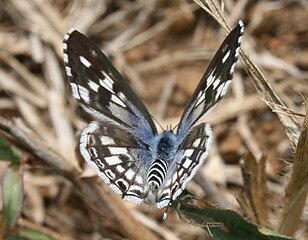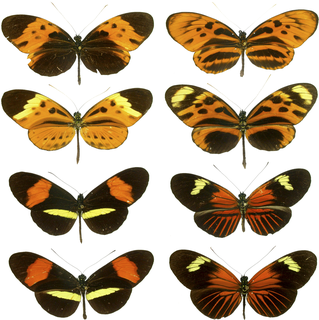
The Heliconiinae, commonly called heliconians or longwings, are a subfamily of the brush-footed butterflies. They can be divided into 45–50 genera and were sometimes treated as a separate family Heliconiidae within the Papilionoidea. The colouration is predominantly reddish and black, and though of varying wing shape, the forewings are always elongated tipwards, hence the common name.

Roland Trimen FRS was a British-South African naturalist, best known for South African Butterflies (1887–89), a collaborative work with Colonel James Henry Bowker. He was among the first entomologists to investigate mimicry and polymorphism in butterflies and their restriction to females. He also collaborated with Charles Darwin to study the pollination of Disa orchids.

Tarucus is a butterfly genus in the family Lycaenidae. They are commonly known as blue Pierrots or simply Pierrots. The latter name is often used for the closely related genus Castalius. The delimitation of Castalius versus Tarucus is not yet fully resolved, with some species, such as the dark Pierrot, having been moved between the two genera repeatedly. It may even be that they are eventually regarded as synonymous, and in that case the older name Castalius would supersede Tarucus by the Principle of Priority.

Junonia is a genus of nymphalid butterflies, described by Jacob Hübner in 1819. They are commonly known as buckeyes, pansies or commodores. This genus flies on every continent except Antarctica. The genus contains roughly 30 to 35 species.
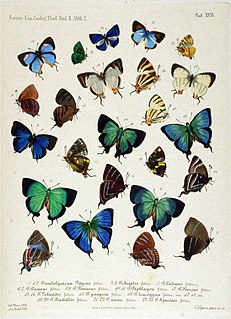
The Eumaeini are a tribe of gossamer-winged butterflies. They are typically placed in the subfamily Theclinae, but sometimes considered a separate subfamily Eumaeinae. Over 1,000 species are found in the Neotropical realm

Orachrysops niobe, the Brenton blue, is a species of butterfly in the family Lycaenidae and is endemic to South Africa.
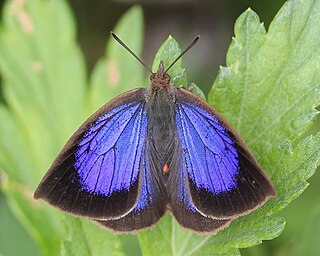
Arhopala is a very large genus of gossamer-winged butterflies (Lycaenidae). They are the type genus of the tribe Arhopalini. In the relatively wide circumscription used here, it contains over 200 species collectively known as oakblues. They occur from Japan throughout temperate to tropical Asia south and east of the Himalayas to Australia and the Solomon Islands of Melanesia. Like many of their relatives, their caterpillars are attended and protected by ants (myrmecophily). Sexual dichromatism is often prominent in adult oakblues.

Castalius is a butterfly genus in the family Lycaenidae. They are commonly known as Pierrots. This name is also often used for the very closely related genus Tarucus.

Lamasina is a genus of gossamer-winged butterflies ; the validity of its name is subject to dispute. Among its family, these sexually dimorphic Lepidoptera belong to the tribe Eumaeini of the subfamily Theclinae. Lamasina species are found mainly in northern South America, approximately to the Guyanas. L. draudti is also found in Central America south of the Yucatán Peninsula. In the Andes, the genus extends somewhat further south; L. rhaptissima almost reaches Bolivia.

Leptotes is a butterfly genus in the family Lycaenidae. They are commonly known as zebra blues in reference to their zebra-striped undersides.
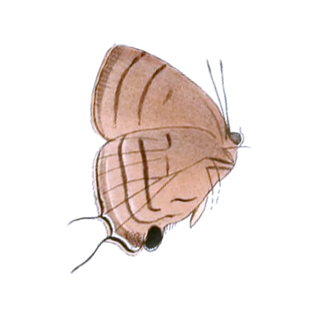
Theritas is a genus of gossamer-winged butterflies found in the Neotropics. Among the tribe Eumaeini of its subfamily Theclinae, it is usually placed in the group around the genus Atlides. In particular, it seems most closely related to Arcas.
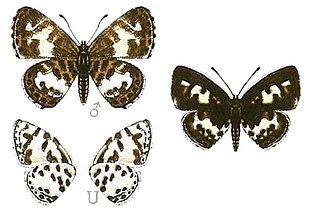
Tuxentius is a butterfly genus in the family Lycaenidae. They are commonly known as pied Pierrots or pies. Contained in this genus are the African species formerly placed in Castalius, except the blue-eyed Pierrot which is separated in Zintha.

Paralethe is a monotypic butterfly genus in the family Nymphalidae. Its one species Paralethe dendrophilus, the bush beauty or forest pride is found in South Africa.
Acraea trimeni or Trimen's acraea is a butterfly of the family Nymphalidae. It is found in only in the arid savannah in the northern Northern Cape and the western part of the Free State.
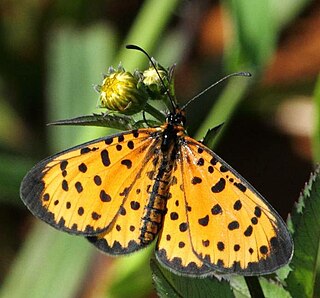
Pardopsis is a monotypic butterfly genus in the family Nymphalidae.

Chrysoritis felthami, the Feltham's opal, is a butterfly of the family Lycaenidae. It is found in South Africa. It was originally described by Roland Trimen under the name Zeritis felthami. This species was named in honour of Henry Louis Langley Feltham.
Chrysoritis phosphor, the scarce scarlet or golden flash, is a butterfly of the family Lycaenidae. The species was first described by Roland Trimen in 1866. It is found in South Africa.

Anthene butleri, the pale hairtail or Butler's ciliate blue, is a butterfly of the family Lycaenidae. It is found from South Africa to Kenya, Uganda, and Ethiopia. In South Africa it is found in coastal lowland forest in KwaZulu-Natal, from the coast to Kosi Bay, inland across the Makathini Flats.

Tuxentius melaena, the black pie or dark pied Pierrot, is a butterfly of the family Lycaenidae. It is found in Africa.

Lepidochrysops trimeni, the Trimen's blue, is a butterfly of the family Lycaenidae. It is found in South Africa, where it is known from the Western Cape.

